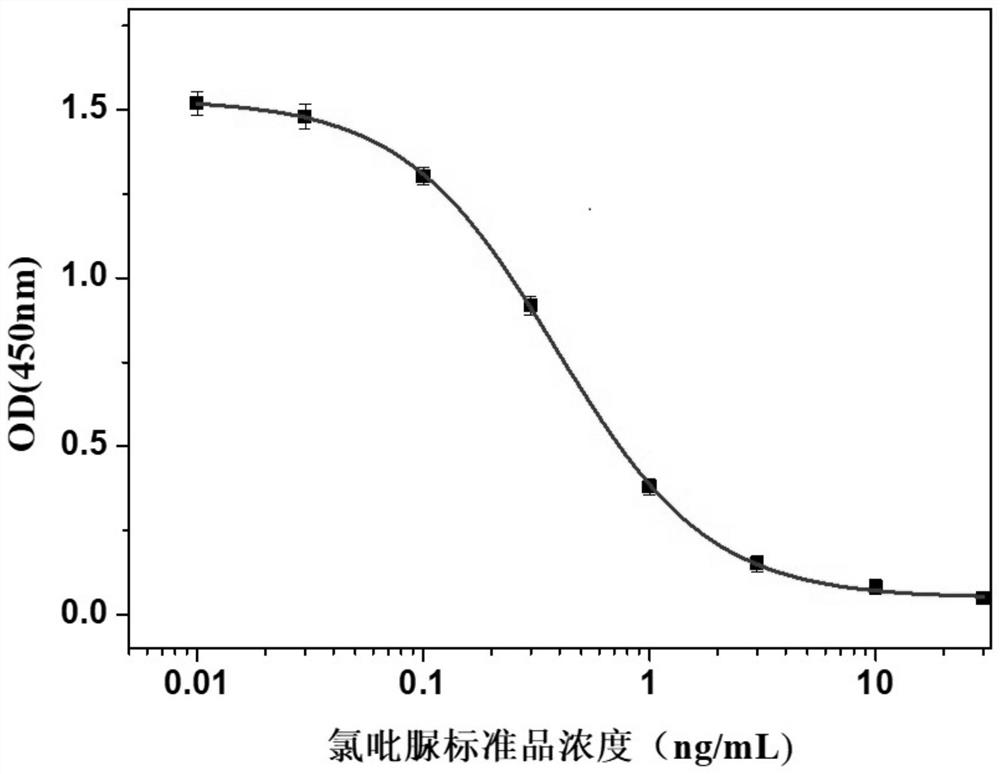Forchlorfenuron monoclonal antibody hybridoma cell strain and application thereof
A technology of forchlorfenuron monoclonal antibody, applied in animal/human protein, serum albumin, biochemical equipment and methods, etc., can solve the problems of high solvent, expensive equipment, consumption, etc., and achieve strong specificity and detection sensitivity The effect of high and good practical application value
- Summary
- Abstract
- Description
- Claims
- Application Information
AI Technical Summary
Problems solved by technology
Method used
Image
Examples
Embodiment 1
[0052] Embodiment 1: the synthesis of forchlorfenuron hapten
[0053] Since the small molecule of forchlorfenuron is not immunogenic and cannot stimulate the immune response of mice to produce antibodies, it is necessary to couple forchlorfenuron to the protein through protein linking technology to obtain immunogenicity; protein coupling Active groups commonly used in the technology include amino, carboxyl, hydroxyl, mercapto, etc. Since the molecular structure of forchlorfenuron does not contain these active groups, it needs to be derivatized.
[0054] Weigh forchlorfenuron 4.95g (20mmol) in a 100ml three-necked flask, dissolve it with 20ml DMSO, and then add KOH 2.25g (40mmol). Another 2.10 g (20 mmol) of β-mercaptopropionic acid was weighed, dissolved in 10 ml DMSO and transferred to a 50 ml constant pressure dropping funnel. Slowly drop the β-mercaptopropionic acid solution into the three-necked flask under stirring, and slowly raise the temperature to 100°C on the oil ba...
Embodiment 2
[0055] Embodiment 2: the synthesis of complete antigen of forchlorfenuron
[0056] Weigh 5.5mg forchlorfenuron hapten, 4.2mg N-hydroxysuccinimide (NHS), dissolve in 300μL N,N-dimethylformamide (DMF), stir at room temperature for 10min; then weigh 6.9mg 1-(3-Dimethylaminopropyl)-3-ethylcarbodiimide hydrochloride (EDC), fully dissolved with 100μL DMF, added to the forchlorfenuron hapten solution, stirred at room temperature for 6-8h (called liquid A). Take 8 mg of BSA, dilute it to 4 mg / mL with 0.01M carbonate buffer (CBS) (referred to as solution B), then slowly add solution A to solution B drop by drop, react at room temperature overnight; then use 0.01M PBS solution Dialyzed to remove unreacted small molecular hapten to obtain the complete antigen, which was identified by UV absorption scanning method.
Embodiment 3
[0057] Embodiment 3: the synthesis of forchlorfenuron coating former
[0058] Dissolve 3.0 mg of forchlorfenuron hapten and 2.3 mg of N-hydroxysuccinimide (NHS) in 300 μL of anhydrous N,N-dimethylformamide (DMF), and stir at room temperature for 10 minutes to obtain forchlorfenuron hapten Solution: Dissolve 3.8mg of 1-(3-dimethylaminopropyl)-3-ethylcarbodiimide hydrochloride (EDC) in 100 μL of anhydrous DMF, add to the forchlorfenuron hapten solution, room temperature Stir and react for 6-8 hours to obtain liquid C; dilute 10 mg of chicken ovalbumin (OVA) with 1 mL of carbonate buffer solution (CBS) with a concentration of 0.01 mmol / L to obtain liquid D; then slowly add liquid A drop by drop React in solution B to obtain reaction solution E; dialyze reaction solution C with PBS solution to remove unreacted small-molecule haptens to obtain the coating original.
PUM
 Login to View More
Login to View More Abstract
Description
Claims
Application Information
 Login to View More
Login to View More - R&D
- Intellectual Property
- Life Sciences
- Materials
- Tech Scout
- Unparalleled Data Quality
- Higher Quality Content
- 60% Fewer Hallucinations
Browse by: Latest US Patents, China's latest patents, Technical Efficacy Thesaurus, Application Domain, Technology Topic, Popular Technical Reports.
© 2025 PatSnap. All rights reserved.Legal|Privacy policy|Modern Slavery Act Transparency Statement|Sitemap|About US| Contact US: help@patsnap.com



